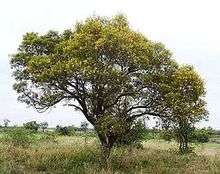Peltophorum africanum
The Weeping wattle (Peltophorum africanum) is a semi-deciduous to deciduous flowering tree growing to about 15 meters tall. It is native to Africa south of the equator. Their yellow flowers bloom on the ends of branches in upright, showy sprays.[1]
| Peltophorum africanum | |
|---|---|
 | |
| Scientific classification | |
| Kingdom: | |
| (unranked): | |
| (unranked): | |
| (unranked): | |
| Order: | |
| Family: | |
| Genus: | |
| Species: | P. africanum |
| Binomial name | |
| Peltophorum africanum | |
During spring time it may happen that water drips from the tree's branches, a phenomenon that is caused by the spittlebug Ptyelus grossus. The immature stages of these spittlebugs congregate on the young shoots and derive their nourishment by sucking the tree's sap. While doing so they secrete pure water, which is the cause of the "weeping" effect.
Common names
Other common names include Rhodesian blackwood, African blackwood, African wattle, African false wattle, Rhodesian wattle and Rhodesian black wattle.[2] It is called Huilboom (i.e. weeping tree) in Afrikaans, due to the effects of the spittlebug.
Gallery

Flowers 
Seed pods 
Wood 
Pods, seeds, immature pods
References
- "PELTOPHORUM AFRICANUM Sond". SANBI. 2001. Retrieved 24 September 2013.
- Ressources Végétales de L'Afrique Tropicale (PROTA) vol 11, part 1 "Plantes médicinales, p. 446, PROTA, 2008 ISBN 9057822067.
External links
| Wikispecies has information related to Peltophorum africanum |

- Peltophorum africanum Sond., Protabase